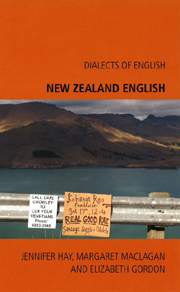Book contents
- Frontmatter
- Contents
- Preface
- Maps
- 1 Geography, Demography and Cultural Factors
- 2 Phonetics and Phonology
- 3 Morphosyntax
- 4 New Zealand Vocabulary and Discourse Features
- 5 The Origins of New Zealand English
- 6 Variation within New Zealand
- 7 Selected Bibliography of Works on New Zealand English
- 8 Sample Texts
- Bibliography of Cited Works
- Index
1 - Geography, Demography and Cultural Factors
Published online by Cambridge University Press: 12 September 2012
- Frontmatter
- Contents
- Preface
- Maps
- 1 Geography, Demography and Cultural Factors
- 2 Phonetics and Phonology
- 3 Morphosyntax
- 4 New Zealand Vocabulary and Discourse Features
- 5 The Origins of New Zealand English
- 6 Variation within New Zealand
- 7 Selected Bibliography of Works on New Zealand English
- 8 Sample Texts
- Bibliography of Cited Works
- Index
Summary
New Zealand – an isolated land
New Zealand is one of the most isolated countries in the world. Its nearest neighbour, Australia, is 1,600km to the west; to the north the closest countries are New Caledonia and Tonga (about 1,700km away); in the south it is 2,300km to Antarctica and it is even further (9,500km) across the Pacific Ocean to Chile in the east. This state of isolation began 80 million years ago when the land mass of New Zealand broke away from the continent of Australia. Before that New Zealand was a very small part of Gondwanaland, the vast Southern supercontinent which in time broke up into the continents of South America, Africa, India, Antarctica and Australia.
New Zealand's physical isolation is responsible for its unique flora and fauna. Some ancient species from Gondwanaland have been preserved there, such as the tuatara, an iguana-like reptile sometimes referred to as a ‘living fossil’. In the New Zealand forests, trees such as the kauri, the rimu and the kahikatea have descended from trees in Gondwanaland and some kauri trees are among the oldest surviving plants in the world. Flightlesss birds which descended from birds of Gondwanaland survived in New Zealand because of the absence of land mammals and other predators.
New Zealand's geological origins are ancient, and in places in the South Island there are rocks which are over 570 million years old. But as well as having ancient origins, New Zealand is also a newly-formed country because of more recent tectonic activity and it has existed in its present state for about 10 million years.
- Type
- Chapter
- Information
- New Zealand English , pp. 1 - 13Publisher: Edinburgh University PressPrint publication year: 2008

